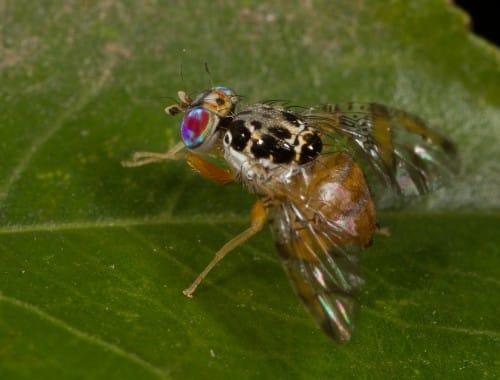The fruit flies (also known as Drosophila) are often used as research subjects in the field of genetics. Not so the flies of the CalTech University (California) research team - these are a model for aviation research.
By: Maya Givon

The fruit flies (also known as Drosophila) are often used as research subjects in the field of genetics. Not so the flies of the CalTech University (California) research team - these are a model for aviation research.
In a study recently published in the Proceedings of the National Academy of Science Proceedings of the National Academy of Science, new insights are published regarding the flies' ability to maintain a constant speed relative to the ground, even in conditions of variable wind. The prevailing view attributes to the complex eyes of the flies - as well as other flying insects - the key role in spatial orientation, and therefore also in the control and control of flight, including maintaining a constant speed and adjusting the speed to the wind resistance. However, recent experiments have produced surprising findings.
The flies at Cal Tech Laboratories in California were placed in a wind tunnel, and were photographed at any given time by five cameras, and from different angles. The cameras fed the data to a computer whose job was to analyze the flies' movement (direction, speed, acceleration, etc.). When they were exposed to bursts of fast wind, at a speed of half a meter per second, they demonstrated the opposite behavior than expected: at the first moment, they accelerated when the wind emerged behind them, or slowed down if the wind came in front of them. Immediately after that, their movement was corrected and they returned to a constant and controlled speed.
The team of researchers believed that the calculation power required by the visual system is extremely large and therefore relatively slow - and wondered if there is an additional sensor that compensates for the delay in the response of the visual system. The solution was discovered in the flies' tentacles. In another experiment, flies with their tentacles removed still accelerated with the direction of the wind, but showed an inability to return and maintain a constant speed relative to the ground.
To examine the role of the visual system separately, the team designed an experiment in which an animation was projected onto the walls of the wind tunnel at a speed that was supposed to trick the flies into thinking there was no change in wind speed. In this experiment as well, the flies responded with a sudden change in acceleration with the direction of the wind - but were unable to return to a constant speed.
From this, the researchers concluded that the wind sensors on the flies' tentacles are responsible for sensing and quickly responding to changes in wind speed, while the information received from the delayed vision system helps them return to a constant speed and maintain it over time. There is actually a mechanism of compensation and savings here: instead of relying only on the "expensive" and slow system of vision, the responsibility for the function was split to another - simpler and much "cheaper" sensor, which is located on the tentacles and provides a specific and quick response to a limited need.
This model may be an inspiration for the construction of small flying robots, even in which maintaining a constant speed is a challenge that requires sensors, some of which require large computing power and slows down the activity. Using an additional simple sensor to calculate this function may solve the problem.

4 תגובות
skeptical,
It is not clear what you noticed because flies meaning small flies is not a scientific definition. When we talk about fruit flies, we are referring to several families of flies that number about 10,000 different species. By the way Drosophila is a genus in one order and the Mediterranean fruit fly is a genus in another family and not as indicated in the article as if it is the same genus.
In short, it's not clear why you call flies, but you won't have a problem finding to learn about them online if you know the scientific name.
beginning,
I would love to know more about the flies.
I first noticed their existence about four years ago.
Before, I didn't notice them. Are they new immigrants to Israel?
b- the speed of maneuvering and the acrobatics they are capable of,
Really amazing.
In this respect at least, they are quite different from the old flies...
Wow what a discovery, they rediscovered the motion sensors on the tentacles. It's just a shame that Christopher Johnson discovered it more than a century ago. Could that be why the aviation sensors on the antenna are called Iver Johnson?
Short and sweet